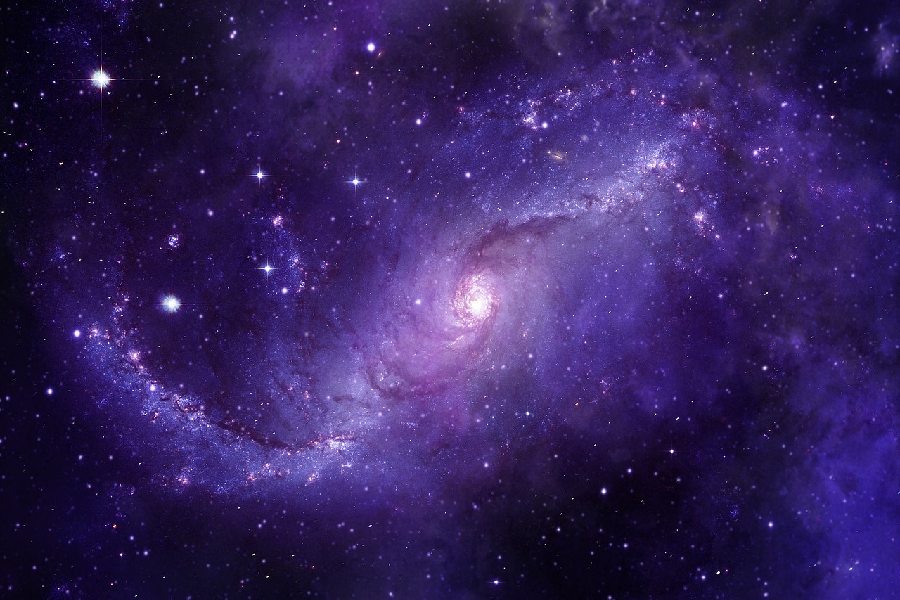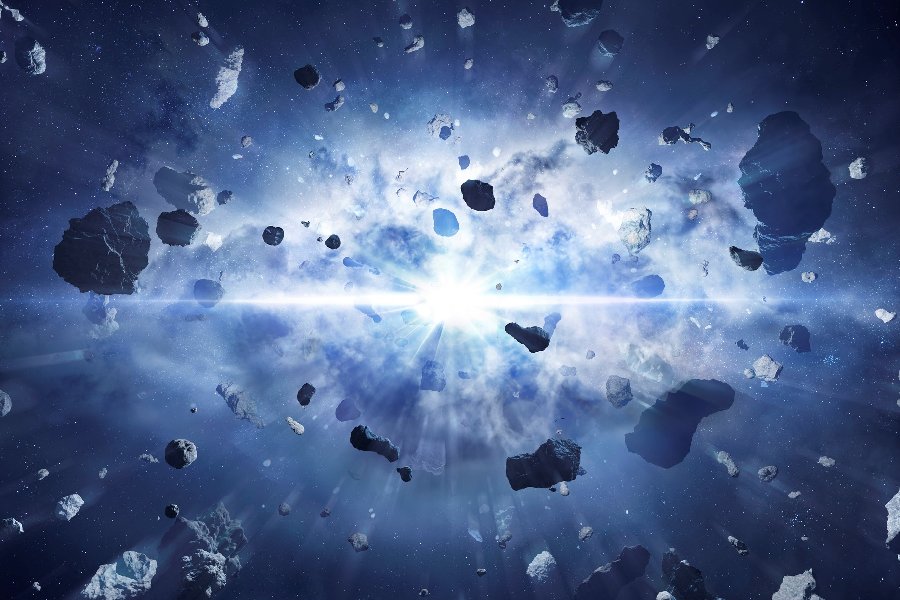In the grand tapestry of cosmic wonders, few questions captivate the human mind as profoundly as the universe’s shape. Imagine peering out into the night sky, pondering the vast expanse surrounding us, and contemplating the very contours of existence. So, what is the shape of the universe? Is the universe flat?
This article will explore the historical and modern theories regarding the universe’s shape. We’ll learn about the spherical, flat, and hyperbolic geometries proposed by cosmologists. Buckle up for a voyage into the unknown, where the very fabric of existence unveils its captivating secrets.

Shape of the Universe
The shape of space is a big mystery in astronomy. Space could be curved like a sphere, flat like a sheet of paper, or saddle-shaped.
Careful studies of background radiation and galaxy clusters hint the universe is flat overall. But space might bend differently on larger scales we can’t see yet.
This means that the universe’s geometry appears consistent with Euclidean geometry on the largest observable scales. However, the overall structure and fate of the universe are still active areas of research and exploration in cosmology.
Defining the abstract notion of “Shape” in cosmology
In our daily experiences, shape refers to the appearance and structure of solid objects. However, shape adopts a more abstract mathematical significance on a cosmic scale.
Space itself can curve and bend in various ways, and the geometry of space dictates this curvature. Cosmologists employ precise mathematical models to articulate the potential shapes of the universe.
These models are crucial in translating observational data into insights about the universe’s topology. It’s important to recognize that when we discuss the shape of space in this context, we are referring to its geometry and curvature, not its visual form.
The interplay of geometry, curvature, and spatial dimensions
The geometry of space determines its curvature. Space can exhibit spherical, flat, or hyperbolic geometry in the realm of two dimensions.
Spherical geometry describes a curved, finite space where the angles of triangles add up to more than 180°. Conversely, flat or Euclidean geometry defines an infinite, uncurved space where triangles have angles summing up to exactly 180°.
Hyperbolic geometry characterizes an open, infinite space with negative curvature, where triangles have angles adding up to less than 180°. As we get into three dimensions, spatial geometry becomes increasingly complex.
The universe could possess positive, negative, or no curvature, and its geometry might differ across cosmological distances. Observing the angles and ratios in distant triangles provides essential clues about the universe’s curvature.
Influencing Factors
Key elements shaping our perception
Our perception of the universe is profoundly influenced by what we observe. The cosmic web, a vast interconnection of galaxies, unfolds primarily through the lens of normal matter. However, lurking in the cosmic shadows are dark counterparts that may manipulate space in ways that elude current instruments, existing beyond the reach of detectable wavelengths.
As the universe continues its expansive journey, it undergoes a dynamic evolution in its geometry. Delving into the realms of measuring distance and growth rate offers valuable insights into the curvature of this cosmic tapestry.
Our position within the vast expanse of the universe tints our observational lens, influencing how we perceive its intricacies. By acknowledging our unique vantage point, we open ourselves to the possibility that alternative perspectives could unveil different cosmic shapes. This invites us to explore the mysteries that lie beyond our current understanding.
The role of expansion and fundamental cosmological principles
The accelerating expansion of space dynamically alters its curvature across time. As the universe undergoes expansion, disparities in curvature become increasingly stretched.
Significant deviations were smoothed out during the inflationary epoch in the early universe, yet residual variations persist on cosmic scales. Fundamental principles serve as the framework for interpreting these observations.
The cosmological principle posits that the universe exhibits homogeneity on vast scales; although anisotropies and inhomogeneities exist, they tend to average out. In line with the Copernican principle, no location holds a central or unique position.
Collectively, these principles suggest that observations from Earth offer a reasonable approximation of the universe’s overall geometry. The ongoing expansion of the universe, coupled with these fundamental principles, forms the basis of our exploration into cosmic shape.
Theories and Models of the Universe’s Shape
Flat, open, and closed universe models
The simplest models describe universes with zero, positive, or negative curvature, which are associated with flat, open, and closed geometries. In a flat universe with Euclidean geometry, space extends uniformly with no overall curvature, and parallel lines never intersect.
An open universe theory features hyperbolic geometry, curving negatively and stretching out infinitely. Parallel lines diverge in this expansive cosmic expanse.
On the other hand, a closed universe theory exhibits positive curvature, looping back on itself in a finite spherical shape, eventually causing parallel lines to converge. The curvature of space intricately determines its geometry and topology, with each model offering unique predictions for parallel lines, triangles, and horizons.
Open universe vs closed universe characteristics
The density of matter and energy is crucial for shaping the universe’s curvature. In cases of higher density, a closed universe manifests positive curvature, contrasting with a flat universe that demands a critical density.
Conversely, lower densities give rise to negative curvature, defining an open universe. Each model unfolds with its destiny: closed universes inevitably collapse, open ones expand infinitely, while flat universes oscillate between finite and infinite possibilities.
Ultimately, the universe’s fate hinges on its overall density: too little matter results in perpetual expansion, while excess leads to eventual contraction. Although precise density measurements enhance our cosmic forecasts, the enigmatic influence of dark energy may still harbor unforeseen revelations.

Unconventional models
Poincaré dodecahedral space and other exotic concepts
Unconventional models delve into more complex shapes, such as Poincaré’s dodecahedral space. It wraps a positively curved universe into a twelve-faced polyhedron. Smoothly reconnecting with itself across the faces, this concept offers an intriguing departure from conventional models.
Other ideas include toroidal universes with donut-like shapes, incorporating strings, branes, or quantum foam. Speculative geometries like hyperbolic tessellations and Picard horns expand the conceptual toolkit for modeling cosmic topology.
Speculative models’ role in broadening cosmic understanding
Speculative and exotic models ignite fresh perspectives on the cosmos, expanding our conceptual horizons. By visualizing alternative shapes, we prepare ourselves for surprises that future observations may unveil.
Diverse ideas serve as fertile ground for creativity and innovation in cosmology’s ongoing quest to map the intricate contours of space. As we conceptualize new geometries and topologies, we challenge the foundations of our spatial intuitions, propelling theories into uncharted cosmic territories.
Observational Clues and Evidence for the Universe’s Shape
Cosmic microwave background radiation (CMB) as a window
The Cosmic Microwave Background (CMB) presents an ancient light from the infancy of the universe, providing a snapshot of its primordial structure. Within its subtle variations lie minuscule temperature differences, which indicate the developing seeds of galaxy formation.
Meticulously mapping the CMB allows scientists to unlock valuable insights into the early universe’s geometry and curvature. This, in turn, refines our understanding of cosmological models.
The CMB provides a unique observational window into the early universe, just 380,000 years after the Big Bang. Precise measurements reveal imprints of infant fluctuations. The CMB’s faint afterglow permeates the entire sky. It holds a wealth of encoded information about early conditions.
Mapping the early universe’s structure: Insights from CMB observations
CMB maps reveal an almost uniformly distributed heat pattern. But small anisotropies exist at a level of 1 in 100,000. These fluctuations reflect quantum variations stretched by inflation. They seeded early gravitational collapse into galaxies.
The cosmic microwave background distribution holds valuable clues regarding spatial curvature. Despite the challenges posed by subtle variations, drawing definitive conclusions becomes difficult. Although the CMB exhibits remarkable uniformity, its minuscule differences provide crucial insights into the curvature of space, particularly at the outer reaches of the observable universe.
Moreover, sophisticated algorithms are pivotal in extracting the underlying geometry embedded in the primordial fluctuations. However, it’s essential to note that relying solely on the CMB may not yield conclusive determinations of cosmic curvature.
Large-scale structures
Cosmic web and filamentary structures
Galaxies form a wispy web around vast voids spanning over a billion light years. The web’s precise architecture comes from early fluctuations shaped by geometry. Subtle hints about curvature underlie its form.
Furthermore, filament patterns show the pathways of matter in the early universe. Immense-scale curvature determines the structures’ geometry. The tangled web arises from quantum uncertainties amplified by inflation. Also, twisted strands trace the underlying spatial fabric.
Galaxy distribution: Clues to the universe’s spatial layout
The three-dimensional map of galaxies probes curvature over cosmic distances. However, current surveys only cover a fraction of the observable universe.
Ongoing efforts aim to chart a representative volume of space. This will better reveal the universe’s large-scale spatial form.
But mysteries remain about the total extent beyond our horizon. The full distribution of galaxies offers the most direct insight into curvature but remains obscured by the vastness of the observable cosmos.
Ongoing Research and Innovations:
Current studies in shape determination
Several major cosmology projects target spatial curvature and geometry. These use a variety of observational probes.
For example, the Planck mission precisely mapped the CMB over the entire sky. Data continues to be analyzed for clues about curvature.
The Sloan Digital Sky Survey maps galaxies in 3D on a large scale. This helps understand space geometry using baryon acoustic oscillations.
Also, the Dark Energy Survey uses galaxy clustering and weak lensing to constrain models. High-precision measurements inform curvature estimates.
Technological innovations and precision instruments
New instruments allow more exact measurements over larger cosmic volumes. This improves curvature constraints.
- Optical and radio telescopes continue to grow in sensitivity and scope.
- Space observatories operate across the electromagnetic spectrum.
- Computational methods extract subtle patterns from massive datasets.
- Machine learning recognizes elusive signals in noisy data.
Together, such innovations drive progress in unraveling the universe’s spatial form. But definitive answers remain on the horizon as cosmologists incrementally map the shape of space.
Conclusion
The shape of the universe stands as one of the most profound mysteries pondered by humanity. Determining the geometry and topology of the cosmos holds keys to understanding the very nature of reality.
While observations and theories provide clues, the ultimate spatial form remains elusive. Yet, the quest itself stretches the imagination and drives breakthroughs in cosmology.
New observational data, computational power, and innovative ideas enrich our cosmic curvature conceptualization. The universe’s precise shape may never be mapped in its entirety.
However, the effort yields insights into the workings of space and time. We hope this has enhanced your appreciation of this captivating field. Our spatial intuitions have been challenged, but our cosmic curiosity has been rewarded in exploring the deep enigma of the universe’s shape.
